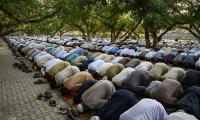Karachi
Breaking: Sheikh Al-Nimr, a Shia political activist, leader and Islamic scholar in Sunni majority Saudi Arabia was executed by royal decree for peacefully advocating for the rights of Shias in the conservative kingdom.
Protests have broken out in Iran, Iraq, Qatif and other Shia bastions; it seems the toxic Sunni-Shia divide has churned out yet another polarising incident that threatens to deepen the rifts within the Islamic world.
This tragic news seems to follow a similar pattern visible around the world, as religious intolerance persists and, unfortunately, seems to be flourishing.
As, on the one hand, warnings of rising ‘Islamaphobia’ around the globe crop up after the Paris attacks, radical Christians continue their war on abortion in the United States, exemplified by the November mass shooting at a Planned Parenthood clinic in Colorado.
Similarly, while sectarian violence remains a pressing problem with Shias being continuously targeted in Pakistan, Yemen, Nigeria, Bahrain, and Iraq, among other countries, inter-faith violence abounds in countries such as the US where Sikhs are constantly under threat from radical right-wing Christian groups.
In essence, it seems as though religions of the world are constantly at odds with each other.
Yet one community in the heart of one of the world’s largest metropolis, Karachi, stands tall as an example for the world in religious tolerance and strong community building.
Saad Rabbani, a local inter-faith activist, and I travelled to a place called Narayan Pura; a neighbourhood in the city’s old Saddar area that houses three different religious minority groups – the Hindus, the Sikhs, and the Christians, all living in harmony with their Muslim neighbours.
Established in 1824 by a Hindu activist named Narayandas, Narayan Pura has been a haven for minority religious groups of Karachi.
From Christmas, to Diwali, to Vaisakhi, all the people of the respective communities take part in each other’s celebrations to solidify their message of acceptance. Even though their worship places are modestly sized, their hearts remain big enough to welcome all with love.
As I walked the corridors of the compound on New Year’s Day, scores of children ran around laughing, smiling and enjoying the music that played in the background. It did not matter to them whether the person was Christian, Hindu, Buddhist, Muslim, yellow, or blue; they just wanted to be the first one on the swing in the courtyard.
As a prominent leader of the area’s Hindu community described it, “We keep a regular attendance in each other’s festivals…and we’ve never had any problems with our Muslim neighbours. In fact, one of our 10-day festivals coincided with Ashura this year; the imambargah located behind us didn’t as much as comment on how loud our music was in the streets!”
And these religious minorities unanimously feel as connected to the Pakistani identity as anyone else in the country. As one person put it, “Look, we have been around since 1824, well before the creation of Pakistan. This is our birthplace. This temple that you stand in was established in 1903! We are Pakistanis!” A Christian leader that I spoke to enthusiastically explained, “To faithfully follow your own faith in a society with a different dominant religion is an incredibly valuable practice. I am proud to be a Christian living in Pakistan.”
Yet, all is not well in this urban oasis of humanity. The community as a whole faces many systematic challenges. Their minority status keeps them from gaining any political power or representation, as structural inequalities run rampant and stymie any chances of growth.
Government-owned and managed apartments lie in ruins with trash scattered across the cramped streets; the ravages of time are clearly visible on the decrepit structures, some of which were erected as early as 1924.
The sewerage system seems to be non-existent as faeces spews out of open gutters, exposing the community members to deadly diseases. Low literacy rate, job discrimination, and police brutality are just some of the concerns of these humbling people as no one in the government seems to even think of helping them.
Despite it all, these people opened up their homes and places of worship with smiling faces and conversed with a total stranger for hours. They never denied a photo or a question – though protecting their identity was a priority for all – and their hospitality seemed to know no bounds. For all this, Narayan Pura truly felt like the soul of Karachi.
Mohammad Raza, a US-based journalism student, can be reached at razam1@uci.edu.
Workers washing 300 KWP solar PV system after its installation on December 4, 2022. — APPThe federal government was...
The Sindh High Court building in Karachi. — Facebook@sindhhighcourt.gov.pk/FileThe Sindh High Court has dismissed...
Sindh Police Chief Ghulam Nabi Memon chairs a meeting at the Central Police Office on December 13, 2024. —...
Saylani Welfare International Trust building seen in this image. — saylaniwebproject/FileThe non-profit Saylani...
MOU signing ceremony between the IBA’s Center for Executive Education and the Pakistan Airports Authority’s Civil...
An aerial view of the commercial district of Pakistan's port city of Karachi. — AFP/FileThe Kingdom of...







